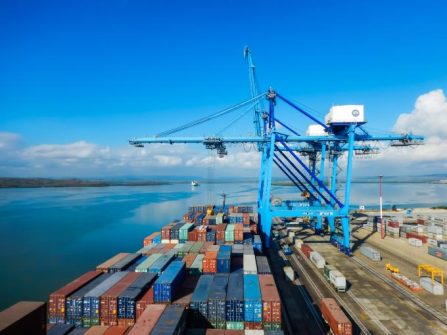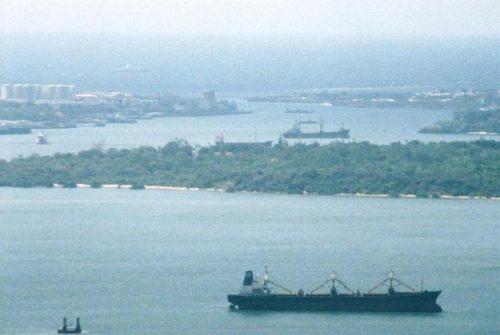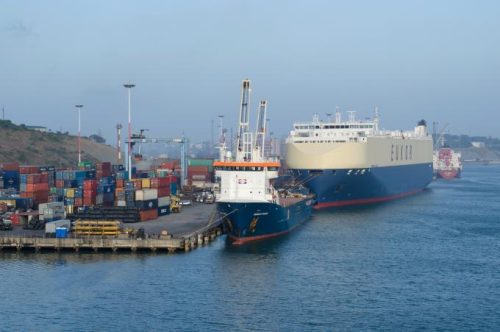Kenya. Mombasa. The first East African port, threatened by congestion and competition.

It is East Africa’s first port, but its development is being challenged by a series of rival projects in Berbera and Djibouti to the north, and Dar es Salaam and Bagamoyo to the south. Almost everywhere, the Emirati company DP World controls the traffic.
By far, the port of Mombasa which was built before Portuguese explorers arrived in the region and was known as “the city of merchants”, is the largest on the eastern coast of Africa. In 2023, the total volume of cargo discharged and loaded at the port reached 35.96 million tonnes. It also handled 1.62 million TEU of containers representing 61 percent of its total capacity of 2.65 million TEU. The state-owned Kenyan Port Authority (KPA) which manages the port expects the traffic of Mombasa to increase up to 47 million tonnes by 2025.
The wider Mombasa port complex now managed by the Danish company AP Moller Maersk, comprises 19 berths, a grain terminal, 2 oil terminals, 6 container berths and 12 berths that handle general cargo. It includes the Kilindini Harbour , the Mbaraki wharf operated by the Bamburi Cement company and the Mbaraki Bulk Terminal that deals with petroleum products. The port also hosts the biggest grain handling facility in Africa. Leading exports include avocado, coffee, tea, vegetables, cashew nuts, fish fillets, and other foodstuffs and beverages.

Port of Mombasa. Cargo operations in the container terminal. Shutterstock/ Ungureanu Catalina Oana.
Transit cargo accounts for about 20 percent of the total volume of traffic since Mombasa is the main outlet for Uganda which accounts for 61 percent of the transit traffic as against 17 percent for South Sudan and four percent for Rwanda. It is also the main outlet for the eastern provinces of the Democratic Republic of Congo which account for 14 percent of the transit volume. According to the KPA, cargo destined for Burundi through Mombasa more than doubled in the first six months of 2023 compared to the same period in 2022. Such traffic is facilitated by railway connections to Uganda and Tanzania and road connections to South Sudan, Ethiopia, Somalia, Rwanda and Burundi.
According to KPA’s Managing Director William Ruto, the improved performance is owed to increased efficiency in operations including the expansion of container handling berths, increased automation of services, acquisition of modern ship and cargo handling equipment. The container vessel turnaround time has improved indeed from an average of three days in 2022 to two days in 2023, reducing the dwell time for containers to three days, from four days.
Yet, the port of Mombasa risks to lose its regional leadership. Kenya’s neighbours are indeed expanding and modernising their port infrastructures. Mombasa’s position is under threat namely because of the ascendance of political considerations over economic interests, claim maritime business sources.
In 2015, the KPA and DP World were encouraged by the Kenyan government to set up a partnership but docker unions who feared job cuts and privatisation opposed to the move.
In a report published in 2022, the London-based African-led Advisory services firm GBS warned that the dominance of Mombasa is being challenged by other regional facilities that are less resistant to badly needed reform. Maritime consultants warn indeed about the “shrinking capacity” at the Mombasa Port which is suffering from congestion, delays, mismanagement and frequent industrial action, accordingly. Kenyan ports have been facing increasing pressure due to rising cargo volume and limited capacity which led to delays in cargo handling and increased costs for shipping companies.

Kilindini Harbour, Mombasa. Photo: CC BY-SA 2.0/Andrew Thomas
Contrasting with William Ruto’s optimistic perspective, a report over the best performing container harbours, published in 2022 by the World Bank and S&P Global Market Intelligence, lists in that order Djibouti, Berbera in Somaliland, Mogadishu and Dar Es Salaam as more performing than Mombasa. One symptom of the congestion problems in the Kenyan port is the 20 percent decrease to 2.3 million tonnes of the volume of transshipment cargo destined for other ports.
“Africa’s Ports: Fast-tracking Transformation” report lists Mombasa, along with Dar es Salaam, Tanzania, and Cape Town, South Africa, as facilities with short-term infrastructure deficits. The report, compiled by the Africa CEO Forum and Okan, a strategy and financial advisory firm, says that without investment, the situation risks worsening in the face of growing demand. Globally, shipowners are looking to maximise profits by carrying more cargo on fewer but larger ships, which can reach 20,000 TEU capacity. Ports are increasingly challenged to provide space to accommodate these monsters.
Dar es Salaam Port is undertaking infrastructural and institutional reforms which may threaten Kenya’s position as a regional hub if plans to build six berths there and in Bagamoyo with public-private partnership financing go ahead. The US$ 421 million Dar es Salaam Maritime Gateway Project (DMGP) is being implemented since 2017 to improve the effectiveness and efficiency of the Dar es Salaam Port. The project, co-financed by the Tanzanian government, the World Bank and the UK’s Foreign, Commonwealth & Development Office, involves the reconstruction and deepening of seven berths to 14.5 metres in order to enable the port to handle large vessels.

Container terminal in port of Mombasa. 123rf
In October 2023, the Dubai-based global port operator DP World signed a 30-year concession agreement with the Tanzania Ports Authority (TPA) to operate and modernise the Dar es Salaam Port, connecting it to the hinterland through a network of roads, highways, railways, and dedicated freight corridors. This modernisation includes investments in cold storage facilities to enhance the agricultural sector,
According to the Shippers Council of Eastern Africa (SCEA), the lobby representing importers and exporters of goods, Ugandan and Rwandan companies are gradually increasing volumes through Dar Es Salaam via the central corridor of only 1,300 km through Tanzania, Rwanda, Burundi, Uganda and Eastern DRC. Dar es Salaam is becoming a regional transshipment hub for tea, coffee, tobacco, oilseeds, cotton, sisal, cashew nuts and copper although it also faces congestion problems. The average waiting period for a ship to offload cargo is five days there. By end 2023, the KPA reported that some ships destined for Tanzania were being diverted to Mombasa.

A beautiful view from a boat of the waving sea and the green coastline in Lamu. The Lamu Port is meant to replace Mombasa’s Kilindini harbour as Kenya’s largest port facility.123rf
Despite the competition, cargo volumes at Mombasa and Dar es Salaam ports have kept growing. In January 2024, Tanzania announced the completion of the DMGP and plans to expand its maritime infrastructure as it opened storage for cargo destined to four East African Community (EAC) states. According to its director Mrisho S. Mrisho, the Port of Dar es Salaam intends to handle 24 million tonnes of cargo in 2023/2024 fiscal year. Besides, the Tanzanian authorities have allowed the China Merchant Holding to develop a 20 million TEU container capacity at the port of Bagamoyo which will be the largest of Eastern Africa. Another regional competitor for Mombasa is the port of Djibouti which has undertaken extensive developments, increasing efficiency at its Doraleh Terminal which is the main outlet for the Djibouti International Free Trade Zone opened in July 2018.
Meanwhile, Kenya has also developed its own domestic alternative. In 2014, the KPA agreed with the China Communication Construction Company for the construction of three berths in the Port of Lamu that forms part of the Lamu Corridor linking it to Sudan and Ethiopia. The idea of Lamu as an alternative to Mombasa emerged in 1975. In 2012, the late President Mwai Kibaki, the then Ethiopian Prime Minister Meles Zenawi and South Sudan’s President Salva Kiir laid the foundation of the Lamu Port South Sudan Ethiopia Transport Corridor (LAPSSET). When completed, the Lamu Port is meant to replace Mombasa’s Kilindini harbour as Kenya’s largest port facility. It would comprise a railway terminal, storage tanks, container freight stations and oil pipeline, oil refineries and several airports. But this project has been stalled owing to regional security concerns on the border with Somalia and political instability in Kenya. Indeed, the corridor should comprise the Lamu-Ethiopia-South Sudan highway, the Lamu-Juba-Addis Ababa railway and a 2,240km pipeline linking oil fields in South Sudan to a new oil refinery at Lamu Port. But the Uhuru Kenyatta administration failed to allocate sufficient resources to the project, with only three berths completed in eight years and the port is currently underutilised because of lack of infrastructure to link it to Ethiopia and South Sudan. DP World aims to operate the three berths in Lamu and create a special economic zone, focused on agricultural activity and servicing the Lamu corridor.

Liquefied cargo carrier in port of Mombasa. 123rf
Yet, the economic viability of the Lamu port is threatened by a recent development. Indeed, Ethiopia, its key target, has turned its focus on the port of Berbera in the non-recognised state of Somaliland, which is set to become the most modern port in the Horn of Africa once completed. Berbera operated by DP World is indeed the closest sea outlet for Ethiopia, an 11-hour journey by road. In May 2016 the Government of Somaliland signed a 30-year agreement with DP World to develop and manage Berbera Port at a cost of $442 million. Recently the DP World Group say that the port, which can currently handle 500,000 will expand into handling one million TEU and up to 2 million TEU at a later stage. According to GBS, Berbera is “the most exciting seaport facility in the region” while the World Bank forecasts that the volumes of cargo handled in Berbera will increase from 3 million to 18 million tonnes between 2016 and 2050. Nevertheless, the KPA keeps defending Mombasa’s leadership. It has expanded the new container terminal of the Port of Mombasa to include two new berths with plans to proceed with a third one. The KPA managing director also announced in early 2024 the dredging of the port channel to accommodate bigger vessels. The KPA’s list of projects includes beside the new Kipevu Oil Terminal - an offshore island facility at the Port of Mombasa that was completed in January 2022 - the third phase of the second container which will increase its capacity by 400,000 TEU which will be funded by the Japanese International Corporation Agency (JICA). At Mombasa Port, DP World has been allocated four berths and turn them into a modern terminal capable of handling one million TEU, remaining thus the main regional player. (Open Photo: Container and tanker vessels in port of Mombasa. Shutterstock/ Druid007)
François Misser



